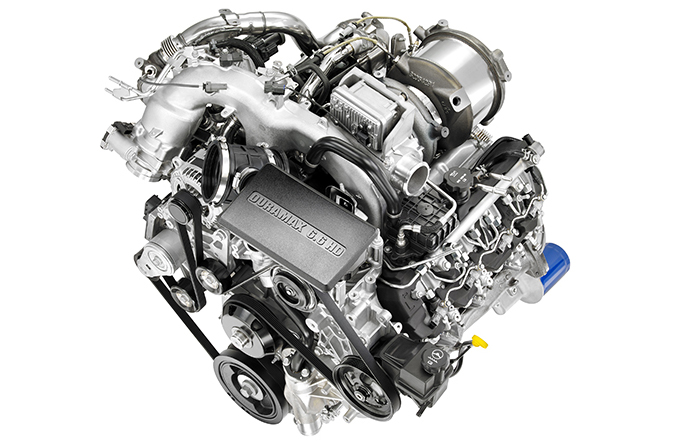The 6.6L Duramax diesel engine (RPO L5P) and Allison 6-speed transmission (RPO MW7) available in 2017-2018 Silverado, Sierra; and 2019 Silverado 2500/3500 and Sierra 2500/3500 models have several different operating characteristics when compared to the previous generation powertrain. Some customers may notice these differences if they owned an earlier 2011-2016 Silverado or Sierra diesel-equipped model.
The new 6.6L Duramax diesel (Fig. 9) shares only bore and stroke dimensions with the previous diesel engine. It features a new GM-developed control system with an electrically-actuated/electronically-controlled turbocharging system and an advanced solenoid fuel system.
 Fig. 9
Fig. 9
The L5P diesel engine is matched to an updated Allison 6-speed transmission (Fig. 10) that’s designed to accommodate the engine’s higher torque capacity.
 Fig. 10
Fig. 10
Following are several operating characteristics of the 6.6L Duramax diesel engine and Allison 6-speed transmission that should be considered normal operation.
Extended Crank
The new engine may take more time to start after turning the key to start than the previous engine due to the change in the fuel system and calibrations.
Transmission Torque Request Override
With 445 horsepower and 910 lb.-ft. of torque, the new engine has increased horsepower and torque compared to the previous diesel engine. After slowing down and then pressing on the accelerator or when changing gears (such as when plowing snow), a short delay in response may be noticed. This delay is designed to help protect the drivetrain from a sudden torque increase. The Transmission Control Module (TCM) overrides the torque request from the driver via the accelerator pedal in order to control engine torque to a level that protects the transmission hardware when making a gear change.
The request override may be noticed most often when a 6th-to-4th gear downshift occurs when applying the accelerator at 70% or greater between 45 and 55 mph (72 and 88 km/h) or when applying the accelerator after a moderate to aggressive braking maneuver from 20-30 mph (32-48 km/h) down to 0-10 mph (0-16 km/h) where a 3rd-to-1st gear downshift occurs.
Transmission Adapt Learns
On a vehicle with relatively low miles, or with low miles since the TCM was reprogrammed, the transmission may seem to shift hard or the engine may seem to flair between shifts. There also may be bumps or jerks when the vehicle downshifts. If this condition is found, it may be necessary to perform a transmission shift adapt quick learn using GDS2.
Change in Torque Converter Lock-up Strategy
In the new 6-speed transmission, the torque converter now locks in 3rd gear instead of 5th gear. As a result, the vehicle will feel more responsive when accelerating from 3rd gear and higher and transmission downshifts may be more noticeable.
On very light accelerator pedal applications when the torque converter is locked, a hesitation, shutter, or stumble may be felt. This feeling is a result of the very high torque the Duramax is capable of producing at low engine speeds as well as the engine being directly coupled to the rear drive wheels. When the torque converter clutch is not locked, it can serve as a viscous damper between the engine and rear drive tires. When the torque converter clutch is locked, 100% of the rapidly increasing torque is delivered to the rear tires.
Differences in DPF Regeneration
There is a difference in the Diesel Particulate Filter regeneration in the new 6.6L diesel engine. The regeneration in these trucks should be shorter, but drivers may find that they are more frequent.
– Thanks to Larry Yaw



















We agree with James Sowers comment above.
For more information on 6.6L Duramax diesel operation, refer to Bulletin #18-NA-334.
I hope to see a bulletin as to these characteristics so that a printable reading material can be presented to the customer to help aid and back up the tech findings in a case where this may be see by the customer as a fault and not just normal.
Thanks